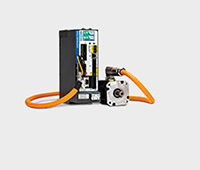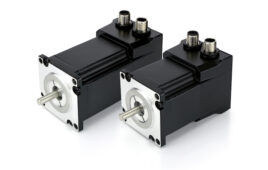By Jeff Nazzaro
Gearhead and Motor Product Manager Parker Hannifin Corp.
Electromechanical Automation, NA
 Robotics represents different things to different industries. When it comes to propulsion, arm joint manipulation, turret rotation, and so on, many robotic manufacturers benefit from using frameless versus housed motors. The benefit comes from the options made possible by incorporating motors into their product designs thanks to space and weight savings and the absence of mechanical linkages that might require maintenance or cut down on the performance of the robots. If something goes wrong with a typical robot, it usually has to go back to the factory unless the staff technician is highly trained in how to take the robot apart and put it back together.
Robotics represents different things to different industries. When it comes to propulsion, arm joint manipulation, turret rotation, and so on, many robotic manufacturers benefit from using frameless versus housed motors. The benefit comes from the options made possible by incorporating motors into their product designs thanks to space and weight savings and the absence of mechanical linkages that might require maintenance or cut down on the performance of the robots. If something goes wrong with a typical robot, it usually has to go back to the factory unless the staff technician is highly trained in how to take the robot apart and put it back together.
However, each sector of the robot industry has a different need relative to motor frame size and power capabilities. And even do-it-yourself design engineers like having a point of contact at the supplier for consultation purposes. During selection, a standard catalog may not provide them with all of the information they need to get the best motor for their needs. That consultative discussion with a motor vendor might include an analysis of the motor at the level of a finite element analysis to understand the necessary efficiencies of the motor and the pros and cons of choosing one motor parameter over another.
Do-it-yourselfers might argue they could get a better solution by customizing an application-specific motor from the ground up, but they know cost and lead times to do that can be prohibitive. That prohibition can be countered, however, by keeping long-term goals in mind. Rapid prototyping can help test the initial concept of what an engineer wants to do. They may decide to go with a higher priced motor with laser cut laminations and a hand-wound stator at the onset. They can do that with the knowledge that going down that path would lead to a more optimized motor that realizes a lower cost thanks to higher volumes and the investment in tooling for a more automated manufacturing process.
What a standard catalog product has going for it is that a technician knows it’s a proven product for the application and that it’s available within standard lead times. And although both standard and custom motors meet industry certifications such as UL, CE, RoHS and REACH, custom motors can add cost and lead time to a project.
Frameless motors come in a range of sizes. And aside from the smaller envelope they represent compared to housed motors, many end users and robot manufacturers may find that their equipment can operate more efficiently and responsively with a frameless motor.
In a typical housed servo application, for example, a shaft comes off the face of the motor, and that is coupled to whatever piece of equipment it needs to drive. Usually that’s done either with a belt and a pulley or with some type of flex coupling. And, with that belt or pulley or flex coupling, there is a level of compliance that affects the system’s reaction capability to move something from point A to point B. Inertia matching, where you want to match the inertia of what you’re driving as closely as possible to the motor, can be critical for these types of applications.
That can be difficult if the motors are very powerful, and they don’t inherently have a lot of inertia. In that case, a motor manufacturer might put a slug on the shaft to increase the motor’s inertia, or might add a gearhead to reduce the reflected inertia to the motor to better match the application. With the direct-drive approach, you take away that mechanical interface between the motor and what you’re driving.
For example, if the rolling wheel of a conveyor has a shaft coming off of it, instead of having a motor shaft attached to it with a coupling, you literally take the rotor of the frameless motor that has a hollow bore in it, slip that over the conveyor shaft, and install the frameless stator as part of a mechanical cap assembly. Then that stator actually envelopes the rotor already on the conveyor shaft, and you’re direct driving the load at that point. That means you can have a smaller motor relative to inertial mismatches because you don’t have that compliance issue. Your only concerns are speed and torque—not inertia matching.
The rule of thumb for a motion control application is that you want an inertial mismatch between load and motor of no more than 5:1. But with a direct-drive solution, this inertial mismatch can increase by 50 times. You don’t have to oversize the motor to create system stability or add components to try to create system stability. You can just go with an optimal motor relative to speed and torque.
The largest investment for an OEM might be the in-house learning curve from understanding how to build a frameless motor into the equipment. As an added incentive, they should keep in mind that for their customer, a frameless motor can be more cost effective than a fully housed motor thanks to lower maintenance and fewer part replacements.
Companies that once relied strictly on housed motors are opening up to the idea of building the motor directly into their equipment—especially in specific industries such as electronics and semi-conductors, where they use robotics for electronic board assembly and wafer handling. Using robots in these environments will increase throughput, reduce errors and will keep the product and the environment as clean as possible.
In other applications, such as in guided vehicles, many users are interested in lower voltage operation to support battery power devices that would not be too heavy for the vehicle, or for safe handling for the people that would be around it, or operating the equipment or vehicle. Common voltages here are 24, 48 and sometimes 60 Vdc. In this, as in all robotic applications, motor efficiencies should be matched with high power densities to keep the motor frame as small as possible and to support a longer battery life.
The many options opening up for robot OEMs and their customers as a result of frameless motors is making automation an easier choice in all industries.
Parker Hannifin Corp.
parker.com
Filed Under: The Robot Report, MOTION CONTROL





Tell Us What You Think!